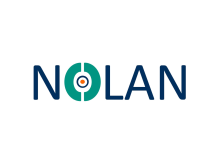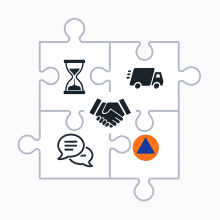At the Chair of General Business Administration, in particular Innovation and Risk Management, we are dedicated to interdisciplinary and practice-relevant issues in the field of innovation, risk and resilience. In times of high uncertainty and disruption, social change with new socio- and techno-economic challenges, innovation capability and resilience are indispensable.
Both in basic research and in application-oriented research projects, a strong focus of our work is on success factors and new models and approaches for cooperation and coordination. This includes, for example, innovative corporate cooperation along the value chain, public-private cooperation in risk and crisis management and cross-border cooperation between companies and authorities.
Our research focuses on the following areas:
- Resilience of networked and complex systems (in particular market systems and supply chain networks as well as critical infrastructures)
- Innovation management and innovation transfer
- Risk and crisis management of supply chains, production systems and projects (e.g. cyber security and cyber resilience).e.g. cyber security and cyber resilience of production; food emergency preparedness)
- Economic behavioural research in the context of risk & innovation
- Business value analysis for resilience strategies
- Innovative forms of cooperation to increase entrepreneurial, regulatory and social resilience
Download research fields
Current projects
Innovation Transfer - Project 4Transfer
The 4-year model project 4transfer is funded by the federal-state initiative "Innovative University" and has a great deal of appeal within the Saxon innovation ecosystem. The network includes the TU Bergakademie Freiberg, the Saxony Cooperative State University, the Meißen University of Applied Sciences and Training Centre and the Saxony State Association of Cultural and Creative Industries
Each institution represents one of the four stakeholders: science, business, administration & politics and civil society. Only the interaction of these four stakeholders enables an optimal transfer of knowledge and technology and thus successful innovations.
In the context of 4transfer, the Chair of Innovation and Risk Management is responsible for the scientific development of the "Impact Survey". The work includes the measurement of innovations, innovation transfer and innovation impact. We analyse how scientific findings can be effectively transferred into economic and social applications. Our work also focuses on the design of innovative transfer structures and the identification of favourable framework conditions for sustainable innovation.

Resilient & Sustainable Value Creation research cluster (RESI-NET)
In the Resilient & Sustainable Value Creation research cluster, several professorships from the Faculty of Business Administration and Economics work together to develop contributions and solutions to the important future topics of circular economy & twin transformation, resilience & security of networked systems, sourcing & raw material criticality and related issues. The aim of RESI-NET's work is to develop practical concepts for a sustainable industrial society.
It is only by pooling the expertise of the participating professorships that these complex research questions can be addressed. The research cluster thus contributes economic expertise to the major strategic topics in which the TU Bergakademie Freiberg is a leader as a resource university.
We are available to you as a cooperation partner for research projects, business and policy advice and as a contact for scientific dialogue.
Please send enquiries to marcus [dot] wiens [at] bwl [dot] tu-freiberg [dot] de (marcus[dot]wiens[at]bwl[dot]tu-freiberg[dot]de) or directly to the colleagues concerned.
Research at the KIT Institute KASTEL-ESS: Economic Aspects of Cyber Security
The digitalisation, automation and networking of industrial, governmental and social systems is in full swing. However, these systems are also becoming more susceptible to attacks from cyberspace at at least the same speed, which can lead to business interruptions, data loss, data manipulation, financial damage or worse. In the process, cyber defence encounters a highly dynamic, highly specialised and organised "shadow industry" that has also long been automated and based on a division of labour. The growing threat, more difficult insurability of cyber risks, but also the higher regulatory requirements (e.g. NIS2, KRITIS umbrella law) are making it increasingly difficult for companies to adapt to this risk.
The Chair of Innovation and Risk Management is a research partner at the Helmholtz Institute for Information Security & Reliability KASTEL-ESS (Topic: Engineering Secure Systems) at the Karlsruhe Institute of Technology. Here, we deal with the strategic analysis and defence against cyber attacks, with cost and damage estimates (including cyber resilience) and with the behavioural implications of this particular risk from a business and economic perspective.
Research at the AI Lab: risk and innovation research of the future
A small laboratory for artificial intelligence (AI Lab for short) has been under construction at TU Bergakademie Freiberg since 2025, complementing the existing laboratory infrastructure at TU Bergakademie Freiberg, which already includes the Robo Lab, the Behavioural Lab and the digitalisation studio for minerals.
In future, the lab will support students, doctoral candidates and project collaborators in integrating AI applications into their work in an informed, responsible and low-threshold manner. The AI Lab will provide support by providing simple programmes (including apps) and tutorials, but will also act as a support network, creating a space for exchange and experimentation. The public is also involved in this initiative. The lab will be open for demonstrations, experiments and dialogue at public events, such as Campus Day, Children's University, etc. For companies in the region, the AI Lab can be a first point of contact for carrying out AI projects with researchers from the university and for gaining expertise and inspiration in exchange with the university on the topic of artificial intelligence.
The lab is organisationally located at the Faculty of Business Administration and Economics and is headed by the Chair of Innovation and Risk Management.
Research profile & references: Selected completed projects
The following selection of completed projects was carried out by the professorship holder mainly until 2021/2022 at or in cooperation with the Karlsruhe Institute of Technology (KIT)
.NOLAN: Scalable emergency logistics for urban areas as a public-private partnership in the event of a disaster
- Term: 2018-2022 | Funding body: BMBF (project coordination by the professorship holder)
- Project partners: Karlsruhe Institute of Technology (KIT); Dresden University of Technology (TUD); 4flow AG
NOLAN was the first time that the option of a public-private partnership in crisis management (Public-Private Emergency Collaboration, PPEC) was systematically researched. The concept of PPECs transfers the basic idea of classic public-private partnerships (PPP), which are primarily known from the infrastructure or education sector, to the area of crisis management. A PPEC encompasses any form of coordination and cooperation between public and private actors with the aim of ensuring that the population is supplied in the event of an emergency. The following hazard scenarios were assumed in the project: (I) contamination of drinking water during a heatwave, (II) shortage of oil and petrol due to geopolitical tensions, (III) failure of electronic payments and (IV) pandemic. The issues investigated are currently particularly relevant in the context of civil defence and will remain an important research focus of the professorship in the future.
PPEC as a concept of public-private cooperation for improved crisis resilience
From a legal perspective, the admissibility and possible forms of structuring a partnership for crisis preparedness were investigated. From an economic perspective, the focus was on the incentives on the part of companies and authorities, the mechanisms and willingness to share information as well as the costs and sharing of risk burdens. In an empirical study to identify supply problems, the stockpiling behaviour of the rural population in Baden-Württemberg was examined in two rounds of surveys (door-to-door surveys immediately before the coronavirus outbreak at the beginning of 2020 with 330 respondents and during the pandemic in summer 2021 with 402 respondents). A critical factor for a PPEC is the willingness of companies to cooperate with the state. Here, the results of a company survey with 398 company representatives from a wide range of sectors showed that most of the companies surveyed are already involved in humanitarian activities and are generally willing to participate in crisis management.
Diehlmann, F.; Lüttenberg, M.; Verdonck, L.; Wiens, M.; Zienau, A. & Schultmann, F. (2021). Public-private collaborations in emergency logistics: A framework based on logistical and game-theoretical concepts. Safety Science, 141, Article no: 105301.
Wiens, M.; Schätter, F.; Zobel, C. & Schultmann, F. (2018). Collaborative Emergency Supply Chains for Essential Goods and Services. In: Fiedrich, F. & Fekete, A. (Eds.): Urban Disaster Resilience and Security, Springer, 145-168.
Lüttenberg, M.; Zienau, A.; Wiens, M.; Hansen, O.; Diehlmann, F. & Schultmann, F. (2025). How to enhance company engagement in public-private emergency collaborations in the supply of essential goods. Journal of Humanitarian Logistics and Supply Chain Management, 15(1), 48-60.
Lüttenberg, M., Schwärzel, A., Klein, M., Diehlmann, F., Wiens, M. & Schultmann, F. (2022). The Attitude of the Population towards Company Engagement in Public-Private Emergency Collaborations and its Risk Perception - A Survey. International Journal of Disaster Risk Reduction, 82(103370).
Wiens, M.; Breitbarth, E.; Diehlmann, F.; Gromitsaris, A.; Gross, W.; Lüttenberg, M.; Michalk, K.; Schulte, M.; Schultmann, F. & Zienau, A. (2020). Intact supply chains in times of crisis with the help of public-private partnerships - The NOLAN project. OR-News, 69, 3rd of August 2020, ISSN 1427-2045, 39-40.
Logistical models (models of emergency logistics) for public-private cooperation in an emergency
The first part of the logistical modelling dealt with the strategic-structural planning of an emergency supply. Our work in this area included the joint planning of emergency wells and water treatment plants, issues relating to the prioritisation of vulnerable sections of the population and the correct choice of public distribution points for emergency goods, such as school playgrounds or large car parks. One focus was on the joint, public-private storage of essential goods, an innovative approach developed by the NOLAN consortium together with representatives of the authorities and companies. The studies included site planning for warehouses based on attractiveness scores and the reform of the stockpiling strategy towards co-operative warehousing, in which public emergency stockpiling is integrated into commercial warehousing.
The second part of the logistical studies focused on the operational-tactical modelling of public-private emergency supply measures. A simulation study analysed the intersection of public and private information for the rapid identification of vulnerable population groups. In two cases, cooperative transport problems were applied to special cases of emergency logistics: One logistical study dealt with the rapid rerouting of retail water transports (Collaborative Vehicle Routing) for the scenario of a regional outage of piped drinking water; in a second logistical study, we investigated the joint use of drones and transporters (Mix Vehicle Routing) for the rapid supply of medicines in the context of a pandemic.
Bakker, H.; Diehlmann, F.; Wiens, M.; Nickel, S. & Schultmann, F. (2023). School or parking lot? Selecting locations for points of distribution in urban disasters. Socio-Economic Planning Sciences, 89.
Stallkamp, C.; Diehlmann, F.; Lüttenberg, M.; Wiens, M.; Volk, R. & Schultmann, F. (2020): On the Combination of Water Emergency Wells and Mobile Treatment Systems: A Case Study of Berlin. Annals of Operations Research.
Diehlmann, F.; Klein, M.; Wiens, M.; Lüttenberg, M.; Schultmann, F. (2022). On the effects of authorities' disaster interventions in Public-Private Emergency Collaborations. International Journal of Disaster Risk Reduction, 79 (103140).
PREVIEW: Resilience of critical transport infrastructures using the example of waterways
- Term: 2018 - 2021 | Funding body: BMBF (project coordination by the professorship holder)
- Project partners: Kalrsruher Institute of Technology (KIT), Karlsruhe University of Applied Sciences (HsKA), antwortING PartGmbB, 4flow AG, Federal Waterways Engineering and Research Institute (BAW)
The aim of the PREVIEW project was to increase the resilience of the waterway infrastructure in Germany. The project consortium investigated the potential impact of the failure of critical water transport infrastructure structures on other transport infrastructure, logistics, neighbouring industries and the population of the adjacent regions as part of a holistic risk management approach. To this end, the impact of damage was analysed and processed using the three hazard scenarios (I) natural events, (II) technical or human error and (III) hostile attacks.
In a first step, the vulnerability of the individual building groups was determined. In the second step, all types of potential or historical damage that could result from a structural failure were recorded and assessed. In particular, a distinction was made between economic damage (for neighbouring industries that cannot be supplied) on the one hand and health hazards (damage to "life and limb" from the perspective of civil protection) on the other. The resulting findings were used to develop crisis plans for the project stakeholders in order to effectively counteract these threats.
The results of the project were incorporated into a simulation model that depicts possible hazard situations using the example of the West German sewer network. PREVIEW-GIS is a GIS-based tool for monitoring the resilience of structures. It comprises the geodata of the hydraulic engineering infrastructure elements of the West German sewer network as well as data for resilience assessment. The tool can provide decision-makers with support for risk-based prioritisation of maintenance measures. The application is based entirely on opensource components for the provision and visualisation of geodata via the Internet. No further requirements are necessary on the client side, as long as a web browser is installed.
Wehrle, R.; Gast, J.; Wiens, M. & Schultmann, F. (2023). On the influence of infrastructure availability on companies decisions toward modal shift and relocation of facilities. Transportation Research Interdisciplinary Perspectives, 19 (100818).
Wehrle, R.; Wiens, M.; Neff, F. & Schultmann, F. (2022). Economic Risk Potential of Infrastructure Failure Considering Inland Waterways. Water, 14(18), 2874.
Wiens, M.; Wehrle, R.; Klein, M. & Schultmann, F. (2022). The resilience of infrastructure systems - The example of waterways. Acamonta, 29th vol. (2022), 38-42.
Wehrle, R.; Wiens, M. & Schultmann, F. (2022). A framework to evaluate systemic risks of inland waterway infrastructure. Progress in Disaster Science, 16.
.INCA: A decision support framework to strengthen disaster resilience in border areas
- Term: 2017 - 2020; Funding organisation: DFG-ANR (project coordination by the professorship holder)
- Project partners: Karlsruhe Institute of Technology (KIT), Bergische Universität Wuppertal (BUW), Université Paris Dauphine, MINES ParisTech
Our societies are increasingly dependent on critical infrastructures, and these dependencies can become problematic, especially in border regions. Against this background, it is important to protect against the failure and consequences of critical infrastructures across borders.
The aim of the interdisciplinary and transnational DFG-ANR project INCA is to increase the cross-border resilience of urban systems to exogenous hazards, such as extreme natural events and/or the collapse of critical infrastructures. The methodological core of the project is an agent-based model that can be used to analyse the reaction of the affected population, the intervention of civil protection actors and the behaviour of volunteers. Based on socio-economic data and clearly defined scenarios, it should be possible to identify weaknesses in cross-border crisis management, improve coordination and cooperation between stakeholder groups and thus contribute to increased resilience of urban systems in border regions. The French-German border region was used as the study area, with the cities of Colmar and Freiburg as the cities under consideration for cross-border cooperation.
A cross-border agent-based model was developed for the interactions analysed in the project. "Agents" in the sense of the model could represent various entities, such as a failed infrastructure due to a power outage, but also the help provided by spontaneous volunteers. An important aspect of the agent-based approach is that it makes it possible to analyse an environment without global information, so that the parameters of the agents can be changed in such a way that it is possible to estimate the effects of coordination errors resulting from different characteristics of the agents. Recommendations for improving cross-border coordination and cooperation in the event of a crisis can be derived from the analyses, thereby improving resilience in the border region.
A second focus of our research was on empirical studies on behavioural economic implications, such as risk perception, willingness to help and social capital in a border region. In one study, we analysed the effects of power outages on the affected population in Germany and France. In a second, large-scale empirical survey, we used an innovative approach to determine the strength of "crossborder attachment", the region-specific social capital and the self-help capacities of the population for the border region and compared them with the values within the respective countries (Germany and France). This approach made it possible for the first time to measure cross-border attachment and understand its significance for self-help capacity.
Adrot, A.; Fiedrich, F.; Lotter, A.; Münzberg, T.; Rigaud, E.; Wiens, M.; Raskob, W. & Schultmann, F. (2018). Challenges in Establishing Cross-Border Resilience. In: Fiedrich, F. & Fekete, A. (eds.): Urban Disaster Resilience and Security, Springer, 429-455.
Klein, M.; Mahdavian, F.; Wiens, M. & Schultmann, F. (2018). A Multi-Agent System to Improve the Resilience of Critical Infrastructure in Cross-Border Disasters. Proceedings of the 11th International Forum on Urbanism (IFOU) Congress 2018 / December 10-11-12, Barcelona (organised by the Urban Resilience Research Network, URNet).
Klein, M.; Wiens, M. & Schultmann, F. (2022). Borderland resilience, willingness to help and trust - An empirical study of the French-German border area. Journal of Behavioural and Experimental Economics, 99, Aug 2022, 101898.
Wiens, M.; Klein, M. & Schultmann, F. (2022). Border Region Attachment - An Empirical Study on Regional Social Capital in the French-German Border Area. CESifo Economic Studies, 68(4), 362-390 [Editor's choice article].
Mahdavian, F.; Platt, S.; Wiens, M.; Klein, M. & Schultmann, F. (2020): Communication blackouts in power outages: Findings from scenario exercises in Germany and France. International Journal of Disaster Risk Reduction, 46(2020).
Klein, M.; Schulte, Y.; Wiens, M.; Fiedrich, F. & Schultmann, F. (2022). Analyse de la coopération transfrontalière dans le domaine de la protection civile (Analysis of cross-border cooperation in civil protection). Breugnot, J. (ed.): Défis linguistiques et culturels pour la gestion des risques dans l'espace rhénan et ailleurs. Langues, sociétés, cultures et apprentissages, 50, 239-260.
.




